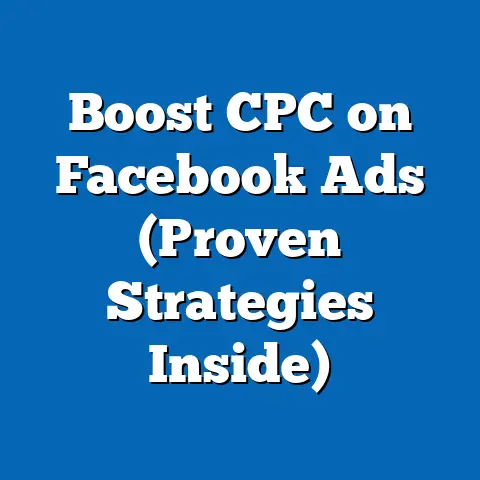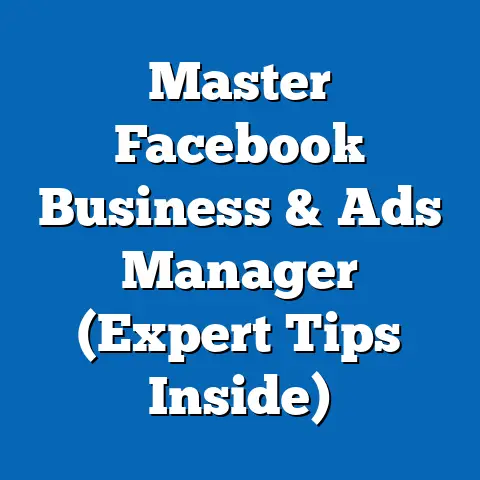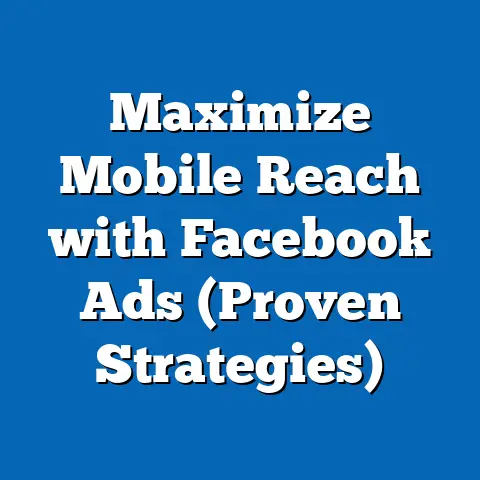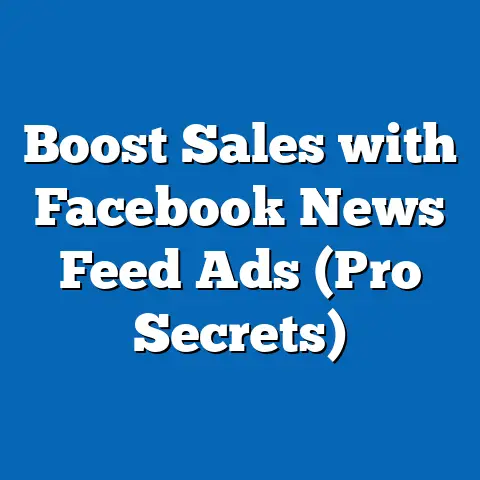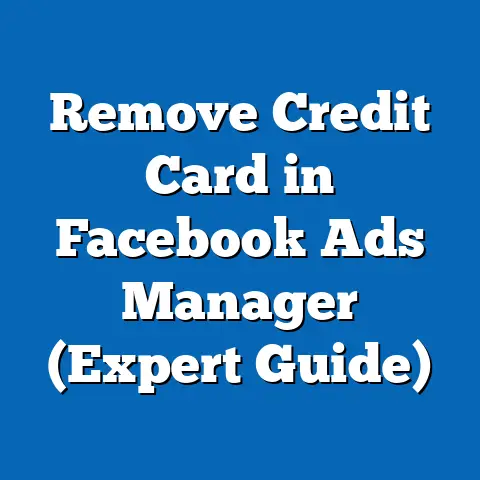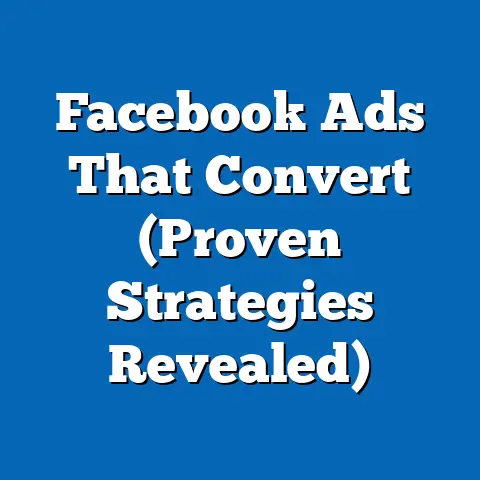Maximize Patient Engagement with Facebook Ads (Proven Tactics)
I’ve seen firsthand how crucial patient engagement is in today’s healthcare landscape. It’s not just about providing medical services; it’s about building relationships, fostering trust, and ensuring patients feel heard and valued. In my experience, healthcare practices that prioritize patient engagement often see higher patient retention rates, improved health outcomes, and a stronger reputation in their communities.
Here’s a quick win: Many healthcare providers I’ve worked with have found success by running Facebook Ad campaigns that offer a free consultation or health assessment. For example, a local dental clinic ran a targeted campaign offering free teeth whitening consultations to new patients. Within just a few weeks, they booked over 50 appointments, converting a significant portion into long-term patients. This tactic works because it provides immediate value, reduces the barrier to entry, and allows potential patients to experience the clinic’s services firsthand.
This article dives deep into the proven tactics you can use to maximize patient engagement through Facebook Ads. I’ll walk you through everything from understanding the basics of Facebook advertising in healthcare to crafting compelling ad content, leveraging patient testimonials, and analyzing your ad performance. Let’s get started!
Understanding Facebook Ads in Healthcare
Overview of Facebook Advertising
Facebook Ads have become a powerful tool for businesses across various industries, and healthcare is no exception. With billions of active users, Facebook offers unparalleled reach and precise targeting capabilities. Unlike traditional advertising methods, Facebook Ads allow you to target specific demographics, interests, behaviors, and even custom audiences based on your existing patient lists.
In the healthcare context, this means you can tailor your ads to reach individuals who are most likely to need your services. For example, if you run a cardiology clinic, you can target individuals over 50 who have shown an interest in heart health or have liked pages related to cardiovascular conditions. This level of precision ensures that your advertising dollars are spent efficiently, reaching the right people with the right message.
The Importance of Patient Engagement
Patient engagement goes beyond simply providing medical care. It involves creating a collaborative relationship between healthcare providers and patients, where patients are actively involved in their own health decisions and care plans. Engaged patients are more likely to adhere to treatment plans, take preventive measures, and communicate effectively with their healthcare providers.
Studies have shown a direct correlation between patient engagement and improved health outcomes. According to a study published in the Journal of Medical Internet Research, patients who are actively engaged in their healthcare experience better chronic disease management, higher satisfaction rates, and reduced hospital readmissions. This underscores the importance of fostering patient engagement as a core component of healthcare delivery.
The Role of Social Media in Healthcare
Social media platforms like Facebook have revolutionized how healthcare providers communicate with their patients. They offer a direct line of communication, allowing providers to share valuable health information, answer questions, and build relationships with their patient base. Social media is no longer just a marketing tool; it’s an essential platform for patient education, support, and engagement.
Facebook, in particular, stands out due to its widespread adoption and versatile features. Healthcare providers can use Facebook to:
- Share educational content: Post articles, videos, and infographics on relevant health topics.
- Announce events and promotions: Promote upcoming health screenings, workshops, and special offers.
- Engage in conversations: Respond to patient questions and comments, fostering a sense of community.
- Gather feedback: Conduct polls and surveys to understand patient needs and preferences.
Takeaway: Facebook Ads can be a highly effective tool for healthcare providers to reach and engage potential patients. Understanding the platform’s capabilities and the importance of patient engagement is crucial for creating successful ad campaigns.
Proven Tactics to Maximize Patient Engagement
Targeting the Right Audience
One of the biggest advantages of Facebook Ads is its sophisticated targeting capabilities. To maximize patient engagement, it’s crucial to define your ideal patient profile and target your ads accordingly.
Demographic Targeting
Demographic targeting allows you to reach specific groups of people based on their age, gender, location, education level, and other demographic characteristics. For healthcare providers, this can be invaluable in reaching the right audience for their services.
Here are some examples of how demographic targeting can be used:
- Pediatric Clinic: Target parents in your local area with children under the age of 10.
- Geriatric Care Facility: Target adults aged 55 and older who live near your facility.
- Women’s Health Clinic: Target women aged 18-50 with interests in reproductive health or prenatal care.
When setting up your demographic targeting, consider the following factors:
- Age: What is the age range of your ideal patient?
- Gender: Are your services more relevant to men or women?
- Location: Where do your patients live? Target specific cities, zip codes, or even neighborhoods.
- Education: Is there a specific education level that is more likely to seek your services?
- Income: While income targeting is less common in healthcare, it may be relevant for certain specialized services.
Custom Audiences
Custom Audiences allow you to target your existing patients on Facebook by uploading a list of their email addresses or phone numbers. This is a powerful way to re-engage with your current patient base and promote new services or offerings.
Here’s how to create a Custom Audience:
- Prepare your patient list: Compile a list of your patients’ email addresses or phone numbers in a CSV or TXT file.
- Upload your list to Facebook Ads Manager: Go to the “Audiences” section in Ads Manager and select “Create Audience” > “Custom Audience.”
- Choose your audience type: Select “Customer List” and upload your file.
- Match identifiers: Facebook will match the information in your list with Facebook users.
Custom Audiences can be used to:
- Promote new services: Announce new treatments or services to your existing patients.
- Offer special discounts: Reward your loyal patients with exclusive discounts or promotions.
- Remind patients to schedule appointments: Send reminders to patients who are due for check-ups or follow-up appointments.
Lookalike Audiences
Lookalike Audiences are a powerful way to reach potential new patients who share similar characteristics with your existing patients. Facebook analyzes your Custom Audience and identifies common traits, such as demographics, interests, and behaviors. It then creates a new audience of people who are similar to your existing patients.
Here’s how to create a Lookalike Audience:
- Create a Custom Audience: You’ll need a Custom Audience of at least 100 people to create a Lookalike Audience.
- Go to the “Audiences” section in Ads Manager: Select “Create Audience” > “Lookalike Audience.”
- Choose your source audience: Select the Custom Audience you want to use as the source.
- Select your audience size: Choose the size of your Lookalike Audience, ranging from 1% to 10% of the total population in your target country. A smaller percentage will result in a more closely matched audience, while a larger percentage will reach a broader audience.
- Choose your location: Select the country or region where you want to target your Lookalike Audience.
Lookalike Audiences can be used to:
- Expand your reach: Reach new patients who are likely to be interested in your services.
- Increase brand awareness: Introduce your practice to a wider audience.
- Drive new patient acquisition: Attract new patients who are similar to your existing patient base.
Takeaway: Effective targeting is essential for maximizing patient engagement with Facebook Ads. Use demographic targeting, Custom Audiences, and Lookalike Audiences to reach the right people with the right message.
Crafting Compelling Ad Content
Once you’ve identified your target audience, the next step is to create compelling ad content that resonates with them. Your ad copy, visual elements, and call-to-action (CTA) should all work together to capture attention and drive engagement.
Writing Effective Ad Copy
Your ad copy is your opportunity to communicate the value of your services and address the needs and concerns of your target audience. Here are some tips for writing effective ad copy:
- Focus on benefits, not features: Instead of listing the features of your services, focus on the benefits they provide to patients. For example, instead of saying “We offer advanced dental implants,” say “Restore your smile and confidence with our advanced dental implants.”
- Use clear and concise language: Avoid using technical jargon or complex medical terms that your audience may not understand.
- Address their pain points: Identify the challenges and concerns of your target audience and address them directly in your ad copy. For example, if you’re targeting people with back pain, you could say “Are you tired of living with chronic back pain? We can help.”
- Use strong verbs and action words: Use verbs that encourage action, such as “Book,” “Schedule,” “Learn More,” or “Get Started.”
- Include a sense of urgency: Create a sense of urgency by using phrases like “Limited Time Offer,” “Book Your Appointment Today,” or “Don’t Miss Out.”
Here are some examples of high-performing ad copy in the healthcare niche:
- Example 1 (Chiropractor): “Suffering from neck pain or headaches? Our chiropractic care can provide lasting relief. Book your consultation today and start feeling better!”
- Example 2 (Dermatologist): “Is acne affecting your confidence? Our expert dermatologists offer personalized treatment plans to help you achieve clear, healthy skin. Learn more and schedule your appointment now!”
- Example 3 (Physical Therapist): “Reclaim your mobility and independence with our physical therapy services. We help you recover from injuries and manage chronic pain. Get back to doing what you love – contact us today!”
Visual Elements
Visual elements, such as images and videos, play a crucial role in capturing attention and conveying your message effectively. Here are some tips for using visual elements in your Facebook Ads:
- Use high-quality images and videos: Avoid using blurry or pixelated images. Invest in professional photography or videography to showcase your services in the best light.
- Choose relevant and engaging visuals: Select images and videos that are relevant to your target audience and the message you’re trying to convey. For example, if you’re promoting a weight loss program, use images of healthy, active people.
- Showcase your team and facilities: Use images and videos that showcase your team, facilities, and equipment. This helps build trust and credibility with potential patients.
- Use before-and-after photos: If appropriate, use before-and-after photos to demonstrate the results of your services. For example, a cosmetic surgeon could use before-and-after photos of patients who have undergone a facelift or rhinoplasty.
- Use videos to educate and engage: Create short videos that educate your audience about health topics, provide tips and advice, or showcase patient testimonials.
Call-to-Action (CTA)
Your call-to-action (CTA) is the final element of your ad that prompts users to take a specific action. It’s crucial to choose a CTA that is clear, concise, and relevant to your ad’s objective.
Here are some examples of effective CTAs for healthcare ads:
- Book Now: Use this CTA to encourage patients to book appointments or consultations.
- Learn More: Use this CTA to direct users to your website or landing page for more information.
- Sign Up: Use this CTA to encourage users to sign up for your newsletter or email list.
- Contact Us: Use this CTA to encourage users to contact your office or schedule a call.
- Get a Free Quote: Use this CTA to offer a free quote or estimate for your services.
When choosing your CTA, consider the following factors:
- Your ad’s objective: What action do you want users to take?
- Your target audience: What CTA is most likely to resonate with them?
- Your landing page: Does your landing page align with the CTA you’ve chosen?
Takeaway: Compelling ad content is essential for capturing attention and driving patient engagement. Write effective ad copy, use high-quality visual elements, and choose a clear and concise CTA.
Utilizing Facebook’s Ad Formats
Facebook offers a variety of ad formats that can be used to engage patients. Each format has its own unique strengths and can be used for different purposes.
Carousel Ads
Carousel ads allow you to showcase multiple images or videos in a single ad unit. This format is ideal for showcasing a range of services, highlighting different aspects of your practice, or telling a story through a series of images.
Here are some ways to use carousel ads in healthcare:
- Showcase multiple services: Highlight different services offered by your practice, such as primary care, specialty care, and wellness services.
- Highlight different aspects of your practice: Showcase your team, facilities, equipment, and patient testimonials.
- Tell a story: Use a series of images or videos to tell a story about a patient’s journey or the benefits of your services.
- Provide health tips: Share a series of health tips or advice in a visually appealing format.
Video Ads
Video ads are a highly engaging format that can be used to capture attention and convey your message effectively. Videos can be used to educate patients about health topics, showcase your team and facilities, or share patient testimonials.
Here are some ideas for video content in healthcare:
- Educational videos: Create short videos that explain common health conditions, provide tips for managing chronic diseases, or demonstrate proper techniques for self-care.
- Meet the doctor videos: Introduce your team and allow patients to get to know you on a personal level.
- Patient testimonial videos: Share patient testimonials that highlight the positive experiences of your patients.
- Facility tours: Showcase your facilities and equipment to give potential patients a glimpse of what to expect.
Lead Ads
Lead ads are a convenient way to collect leads from potential patients without requiring them to leave Facebook. When users click on a lead ad, they are presented with a pre-filled form that they can submit with just a few taps.
Lead ads can be used to:
- Book appointments: Allow patients to book appointments directly from your ad.
- Sign up for newsletters: Collect email addresses for your newsletter or email list.
- Request more information: Allow potential patients to request more information about your services.
- Download resources: Offer free resources, such as e-books or guides, in exchange for contact information.
Takeaway: Facebook offers a variety of ad formats that can be used to engage patients. Experiment with different formats to see what works best for your practice and your target audience.
Leveraging Patient Testimonials and Reviews
Patient testimonials and reviews are a powerful form of social proof that can significantly influence potential patients’ decisions. Showcasing positive patient experiences can enhance your credibility, build trust, and drive engagement.
The Power of Social Proof
Social proof is a psychological phenomenon where people tend to follow the actions of others, especially when they are uncertain about what to do. In the context of healthcare, potential patients often rely on testimonials and reviews to make informed decisions about their care.
Positive testimonials and reviews can:
- Build trust: Show potential patients that others have had positive experiences with your practice.
- Enhance credibility: Demonstrate your expertise and commitment to patient care.
- Influence decisions: Encourage potential patients to choose your practice over competitors.
- Drive engagement: Encourage potential patients to contact your office or book an appointment.
Creating Ad Campaigns Around Testimonials
Here are some ways to create Facebook Ads that highlight positive patient experiences:
- Use quotes in your ad copy: Incorporate short, impactful quotes from patient testimonials into your ad copy.
- Feature testimonials in your visual elements: Use images or videos of patients sharing their positive experiences.
- Create carousel ads with multiple testimonials: Showcase a series of testimonials in a carousel ad format.
- Run retargeting campaigns with testimonials: Target users who have visited your website or interacted with your Facebook page with ads featuring testimonials.
Engaging with Reviews
Engaging with patient feedback and reviews on Facebook is crucial for fostering engagement and building relationships. Responding to both positive and negative reviews shows that you value patient feedback and are committed to providing excellent care.
Here are some tips for engaging with reviews:
- Respond promptly: Respond to reviews as quickly as possible, ideally within 24-48 hours.
- Acknowledge the reviewer: Thank the reviewer for their feedback and address them by name.
- Personalize your response: Avoid using generic responses. Tailor your response to the specific comments made by the reviewer.
- Address concerns and offer solutions: If the review is negative, acknowledge the patient’s concerns and offer a solution or resolution.
- Invite further discussion: Encourage the reviewer to contact your office directly to discuss their concerns in more detail.
Takeaway: Patient testimonials and reviews are a powerful tool for building trust and driving engagement. Showcase positive patient experiences in your ads and engage with reviews to foster relationships with your patient base.
Analyzing and Optimizing Ad Performance
Once you’ve launched your Facebook Ads, it’s crucial to track your performance and make adjustments as needed. Analyzing your ad performance allows you to identify what’s working, what’s not, and how you can optimize your campaigns for better results.
Key Metrics to Track
Here are some essential metrics to track when analyzing your Facebook Ad performance:
- Reach: The number of unique people who saw your ad.
- Impressions: The number of times your ad was displayed.
- Click-Through Rate (CTR): The percentage of people who saw your ad and clicked on it.
- Cost Per Click (CPC): The average cost you paid for each click on your ad.
- Conversion Rate: The percentage of people who clicked on your ad and completed a desired action, such as booking an appointment or signing up for a newsletter.
- Cost Per Conversion (CPC): The average cost you paid for each conversion.
- Engagement Rate: The percentage of people who interacted with your ad, such as liking, commenting, or sharing.
A/B Testing
A/B testing, also known as split testing, involves testing different versions of your ads to see which performs best. You can test different ad copy, visual elements, CTAs, or targeting options to identify the most effective combination.
Here are some tips for A/B testing your Facebook Ads:
- Test one element at a time: To accurately measure the impact of each element, test only one variable at a time.
- Create clear hypotheses: Before running your test, define what you expect to happen and why.
- Use a control group: Keep one version of your ad unchanged as a control group to compare against your test versions.
- Run your test for a sufficient period: Allow your test to run long enough to gather statistically significant data.
- Analyze your results and implement changes: Once your test is complete, analyze the results and implement the changes that improved performance.
Adjusting Strategies Based on Data
Based on your analytics and performance data, you can adjust your ad strategies to improve results. Here are some examples of how to adjust your strategies:
- Refine your targeting: If your ads are not reaching the right audience, refine your targeting options.
- Update your ad copy: If your ad copy is not resonating with your audience, try different messaging or value propositions.
- Change your visual elements: If your visual elements are not capturing attention, try different images or videos.
- Adjust your budget: If your ads are performing well, consider increasing your budget to reach a larger audience.
- Pause or eliminate underperforming ads: If your ads are not performing well, pause or eliminate them to focus on more effective campaigns.
Takeaway: Analyzing and optimizing your ad performance is crucial for maximizing patient engagement. Track key metrics, A/B test different elements, and adjust your strategies based on data to improve your results.
Case Studies
Successful Campaigns
To illustrate the effectiveness of Facebook Ads in healthcare, let’s look at a few case studies of healthcare providers who have successfully used the platform to enhance patient engagement.
Case Study 1: Orthopedic Clinic
An orthopedic clinic in a mid-sized city wanted to increase awareness of its services and attract new patients. They launched a Facebook Ad campaign targeting adults aged 35-65 with interests in sports, fitness, and joint pain.
Their campaign included:
- Carousel Ads: Showcasing different orthopedic services, such as joint replacement, sports medicine, and physical therapy.
- Video Ads: Featuring patient testimonials and interviews with their orthopedic surgeons.
- Lead Ads: Offering a free consultation to potential patients.
Results:
- Increased website traffic by 40%
- Generated 150 qualified leads
- Converted 25% of leads into new patients
Case Study 2: Mental Health Clinic
A mental health clinic wanted to reach individuals struggling with anxiety and depression. They launched a Facebook Ad campaign targeting adults aged 25-45 with interests in mental health, wellness, and self-care.
Their campaign included:
- Image Ads: Featuring calming imagery and supportive messaging.
- Ad Copy: Addressing the stigma surrounding mental health and encouraging people to seek help.
- CTA: Directing users to a landing page with information about their services and a link to schedule an appointment.
Results:
- Increased website traffic by 60%
- Generated 200 inquiries about their services
- Improved brand awareness and reduced stigma surrounding mental health
Case Study 3: Dental Practice
A dental practice wanted to promote their teeth whitening services and attract new patients. They launched a Facebook Ad campaign targeting adults aged 25-55 with interests in cosmetic dentistry, teeth whitening, and oral hygiene.
Their campaign included:
- Image Ads: Featuring before-and-after photos of patients who had undergone teeth whitening treatments.
- Ad Copy: Highlighting the benefits of teeth whitening, such as improved confidence and a brighter smile.
- CTA: Offering a limited-time discount on teeth whitening services.
Results:
- Increased website traffic by 50%
- Generated 100 new teeth whitening appointments
- Increased revenue by 20%
Lessons Learned
These case studies highlight several key lessons for healthcare providers looking to enhance patient engagement with Facebook Ads:
- Define your target audience: Clearly define your target audience based on demographics, interests, and behaviors.
- Create compelling ad content: Use engaging ad copy, high-quality visual elements, and a clear CTA.
- Utilize Facebook’s ad formats: Experiment with different ad formats to see what works best for your practice.
- Leverage patient testimonials: Showcase positive patient experiences to build trust and credibility.
- Analyze and optimize your ad performance: Track key metrics, A/B test different elements, and adjust your strategies based on data.
Takeaway: These case studies demonstrate the potential of Facebook Ads to enhance patient engagement and drive business results for healthcare providers.
Conclusion
In this article, I’ve explored proven tactics to maximize patient engagement through Facebook Ads. I’ve covered everything from understanding the basics of Facebook advertising in healthcare to crafting compelling ad content, leveraging patient testimonials, and analyzing your ad performance.
Recap of Key Points
Here’s a recap of the key points discussed in this article:
- Target the right audience: Use demographic targeting, Custom Audiences, and Lookalike Audiences to reach the right people with the right message.
- Craft compelling ad content: Write effective ad copy, use high-quality visual elements, and choose a clear and concise CTA.
- Utilize Facebook’s ad formats: Experiment with different ad formats to see what works best for your practice.
- Leverage patient testimonials and reviews: Showcase positive patient experiences to build trust and credibility.
- Analyze and optimize ad performance: Track key metrics, A/B test different elements, and adjust your strategies based on data.
Future of Facebook Ads in Healthcare
The future of Facebook Ads in healthcare looks promising, with ongoing advancements in targeting capabilities, ad formats, and analytics. As Facebook continues to evolve, healthcare providers will have even more opportunities to reach and engage their target audience.
Some future trends to watch include:
- Increased use of artificial intelligence (AI): AI-powered tools will help healthcare providers automate and optimize their ad campaigns.
- Personalized ad experiences: Ads will become increasingly personalized based on individual patient preferences and needs.
- Integration with telehealth services: Facebook Ads will be used to promote and facilitate telehealth services.
- Focus on patient privacy and data security: Healthcare providers will need to prioritize patient privacy and data security when using Facebook Ads.
Call to Action for Healthcare Providers
I encourage you to take action by implementing the strategies discussed in this article and experimenting with Facebook Ads to see tangible results. Start by defining your target audience, crafting compelling ad content, and tracking your performance. Don’t be afraid to test different approaches and adjust your strategies based on data.
By leveraging the power of Facebook Ads, you can enhance patient engagement, attract new patients, and improve the overall health and well-being of your community.

